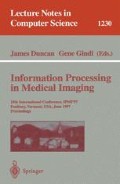Abstract
The effects of reconstructing low resolution 3D time-of-flight MR images using zero-filled interpolation were examined using observer performance measures. Two alternative forced choice experiments using digital subtraction angiography images as a truth standard were performed. MR angiography data were acquired from six patient volunteers and were reconstructed with and without zero-filled interpolation. The MR angiography images were evaluated by generating divergent maximum intensity projection images with the same view as digital subtraction angiography images obtained on the patients as part of their clinical workup. The projection images were evaluated by three observers. Zerofilled interpolation significantly increased the detectibility of very small vessels (diameters less than 0.7 mm) but had no significant effect on larger vessels.
Preview
Unable to display preview. Download preview PDF.
References
Y. P. Du, D. L. Parker, W. L. Davis, and G. Gao. Reduction of partial-volume artifacts with zero-filled interpolation in three-dimensional MR angiography. Journal of Magnetic Resonance Imaging, 4:733–741, 1994.
D. D. Blatter, D. L. Parker, and R. O. Robison. Cerebral MR angiography with multiple overlapping thin slab acquisition: part I. quantitative analysis of vessel visibility. Radiology, 179:805–811, 1991.
M. P. Eckstein and J. S. Whiting. Visual signal detection in structured background I. effect of number of possible spatial locations and signal contrast. Journal of the Optical Society of America A, 13:1777–1787, 1996.
A. E. Burgess. Comparison of receiver operating characteristic and forced choice observer performance measurement methods. Medical Physics, 22:643–655, 1995.
J. A. Hanley and B. J. McNeil. The meaning and the use of the area under a receiver operating characteristic (ROC) curve. Diagnostic Radiology, 143:29–36, 1982.
D. L. Parker, Y. P. Du, and W. L. Davis. The voxel sensitivity function in Fourier transform imaging: applications to magnetic resonance angiography. Magnetic Resonance in Medicine, 33:156–162, 1995.
B. E. Chapman, A. R. Sanderson, K. C. Goodrich, A. Alexander, D. D. Blatter, and D. L. Parker. A two alternative forced choice evaluation of blood vessel visibility in MR angiograms. In Proceedings of the ISMRM 4th Scientific Meeting, 1996.
B. E. Chapman, A. R. Sanderson, K. C. Goodrich, A. Alexander, D. D. Blatter, and D. L. Parker. Observer performance methodologies for evaluating blood vessel visibility in MR angiograms using accurate geometric registration to high resolution x-ray angiograms. to appear, Magnetic Resonance in Medicine.
D. C. Noll, D. G. Nishimura, and A. Macovski. Homodyne detection in magnetic resonance imaging. IEEE Transactions on Medical Imaging, 10:154–163, 1991.
J. A. Swets and R. M. Pickett. Evaluation of Diagnostic Systems. Academic Press, New York, 1982.
Author information
Authors and Affiliations
Editor information
Rights and permissions
Copyright information
© 1997 Springer-Verlag Berlin Heidelberg
About this paper
Cite this paper
Chapman, B.E., Goodrich, K.C., Alexander, A.L., Blatter, D.D., Parker, D.L. (1997). Two alternative forced choice evaluation of vessel visibility increases due to zero-filled interpolation in MR angiography. In: Duncan, J., Gindi, G. (eds) Information Processing in Medical Imaging. IPMI 1997. Lecture Notes in Computer Science, vol 1230. Springer, Berlin, Heidelberg. https://doi.org/10.1007/3-540-63046-5_57
Download citation
DOI: https://doi.org/10.1007/3-540-63046-5_57
Published:
Publisher Name: Springer, Berlin, Heidelberg
Print ISBN: 978-3-540-63046-3
Online ISBN: 978-3-540-69070-2
eBook Packages: Springer Book Archive

